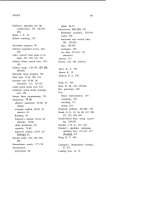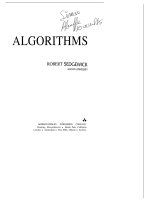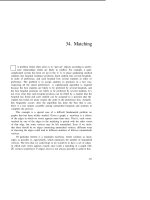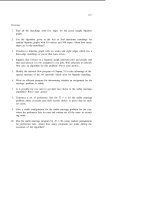Tài liệu Thuật toán Algorithms (Phần 3) pdf
Bạn đang xem bản rút gọn của tài liệu. Xem và tải ngay bản đầy đủ của tài liệu tại đây (115.71 KB, 10 trang )
expected to take on “typical” input data, and in the worst case, the amount
of time a program would take on the worst possible input configuration.
Many of the algorithms in this book are very well understood, to the point
that accurate mathematical formulas are known for the average- and
case running time. Such formulas are developed first by carefully studying
the program, to find the running time in terms of fundamental mathematical
quantities and then doing a mathematical analysis of the quantities involved.
For some algorithms, it is easy to out the running time. For ex-
ample, the brute-force algorithm above obviously requires
iterations of the while loop, and this quantity dominates the running time if
the inputs are not small, since all the other statements are executed either
0 or 1 times. For other algorithms, a substantial amount of analysis is in-
volved. For example, the running time of the recursive Euclidean algorithm
obviously depends on the “overhead” required for each recursive call (which
can be determined only through detailed1 knowledge of the programming en-
vironment being used) as well as the number of such calls made (which can
be determined only through extremely sophisticated mathematical analysis).
Several important factors go into this analysis which are somewhat out-
side a given programmer’s domain of influence. First, Pascal programs are
translated into machine code for a given computer, and it can be a challenging
task to figure out exactly how long even one Pascal statement might take to
execute (especially in an environment where resources are being shared, so
that even the same program could have varying performance characteristics).
Second, many programs are extremely sensitive to their input data, and per-
formance might fluctuate wildly depending on the input. The average case
might be a mathematical fiction that is not representative of the actual data
on which the program is being used, and the worst case might be a bizarre
construction that would never occur in practice. Third, many programs of
interest are not well understood, and specific mathematical results may not
be available. Finally, it is often the case that programs are not comparable at
all: one runs much more efficiently on one particular kind of input, the other
runs efficiently under other circumstances.
With these caveats in mind, we’ll use rough estimates for the running
time of our programs for purposes of classification, secure in the knowledge
that a fuller analysis can be done for important programs when necessary.
Such rough estimates are quite often easy to obtain via the old programming
saw “90% of the time is spent in 10% of the code.” (This has been quoted in
the past for many different values of
The first step in getting a rough estimate of the running time of a program
is to identify the inner loop. Which instructions in the program are executed
most often? Generally, it is only a few instructions, nested deep within the
CHAPTER 1
control structure of a program, that absorb all of the machine cycles. It is
always worthwhile for the programmer to be aware of the inner loop, just to
be sure that unnecessary expensive instructions are not put there.
Second, some analysis is necessary to estimate how many times the inner
loop is iterated. It would be beyond the scope of this book to describe the
mathematical mechanisms which are used in such analyses, but fortunately
the running times many programs fall into one of a few distinct classes. When
possible, we’ll give a rough description of the analysis of the programs, but it
will often be necessary merely to refer to the literature. (Specific references
are given at the end of each major section of the book.) For example, the
results of a sophisticated mathematical argument show that the number of
recursive steps in Euclid’s algorithm when is chosen at random less than is
approximately ((12 1
n Often, the results of a mathematical analysis
are not exact, but approximate in a precise technical sense: the result might
be an expression consisting of a sequence of decreasing terms. Just as we are
most concerned with the inner loop of a program, we are most concerned with
the leading term (the largest term) of a mathematical expression.
As mentioned above, most algorithms have a primary parameter N,
usually the number of data items to be processed, which affects the running
time most significantly. The parameter N might be the degree of a polyno-
mial, the size of a file to be sorted or searched, the number of nodes in a
graph, etc. Virtually all of the algorithms in this book have running time
proportional to one of the following functions:
1
Most instructions of most programs are executed once or at most
only a few times. If all the instructions of a program have this
property, we say that its running time is constant. This is obviously
the situation to strive for in algorithm design.
log N When the running time of a program is logarithmic, the program
gets slightly slower as N running time commonly occurs
in programs which solve a big problem by transforming it into a
smaller problem by cutting the size by some constant fraction. For
our range of interest, the running time can be considered to be less
than a constant. The base of the logarithm changes the
constant, but not by much: when N is a thousand, log N is 3 if the
base is 10, 10 if the base is 2; when N is a million, is twice
as great. Whenever N doubles, log N increases by a constant, but
log N doesn’t double until N increases to
N When the running time of a program is linear, it generally is the case
that a small amount of processing is done on each input element.
When N is a million, then so is the running time. Whenever N
15
doubles, then so does the running time. This is the optimal situation
for an algorithm that must process N inputs (or produce N outputs).
This running time arises in algorithms which solve a problem by
breaking it up into smaller solving them independently,
and then combining the solutions. For lack of a better adjective
we’ll say that running time of such an algorithm
is “N log N.” When N is a million, N log N is perhaps twenty
million. When N doubles, the running time more than doubles (but
not much more).
When the running time of an algorithm is quadratic, it is practical
for use only on relatively small problems. Quadratic running times
typically arise in algorithms which process all pairs of data items
(perhaps in a double nested loop). When N is a thousand, the
running time is a million. Whenever N doubles, the running time
increases fourfold.
Similarly, an algorithm which triples of data items (perhaps
in a triple-nested loop) has a cubic running time and is practical for
use only on small problems. N is a hundred, the running
time is a million. Whenever N doubles, the running time increases
eightfold.
Few algorithms with exponential running time are likely to be ap-
propriate for practical use, though such algorithms arise naturally as
“brute-force” solutions to problems. When N is twenty, the running
time is a million. Whenever N doubles, the running time squares!
The running time of a particular is likely to be some constant
times one of these terms (the “leading term”) plus some smaller terms. The
values of the constant coefficient and the terms included depends on the results
of the analysis and on implementation details. Roughly, the coefficient of the
leading term has to do with the number of instructions in the inner loop:
at any level of algorithm design it’s prudent to limit the number of such
instructions. For large N the effect of the leading term dominates; for small
N or for carefully engineered algorithms, more terms may contribute and
of algorithms are more difficult. In most cases, we’ll simply refer
to the running time of programs as “linear,” log N, etc., with
the implicit understanding that more detailed analysis or empirical studies
must be done in cases where efficiency is very important.
A few other functions do arise. For example, an algorithm with
inputs that has a running time that is cubic in N is more properly classed
as an algorithm. Also some algorithms have two stages of subproblem
decomposition, which leads to a running time proportional to N(log Both
CHAPTER 1
of these functions should be considered to be much closer to N log N than to
for large N.
One further note on the “log” function. As mentioned above, the base
of the logarithm changes things only by a constant factor. Since we usually
deal with analytic results only to within a constant factor, it doesn’t matter
much what the base is, so we refer to etc. On the other hand,
it is sometimes the case that concepts can be explained more clearly when
some specific base is used. In mathematics, the logarithm (base e =
2.718281828.. arises so frequently that a special abbreviation is commonly
used: log, N N. In computer science, the binary logarithm (base 2) arises
so frequently that the abbreviation log, N lg N is commonly used. For
example, lg N rounded up to the nearest integer is the number of bits required
to represent N in binary.
Implementing Algorithms
The algorithms that we will discuss in this book are quite well understood,
but for the most part we’ll avoid excessively detailed comparisons. Our goal
will be to try to identify those algorithms which are likely to perform best for
a given type of input in a given application.
The most common mistake made in the selection of an algorithm is to
ignore performance characteristics. Faster algorithms are often more compli-
cated, and implementors are often willing to accept a slower algorithm to
avoid having to deal with added complexity. But it is often the case that
a faster algorithm is really not much more complicated, and dealing with
slight added complexity is a small price to pay to avoid dealing with a slow
algorithm. Users of a surprising number of computer systems lose substantial
time waiting for simple quadratic algorithms to finish when only slightly more
complicated N log N algorithms are available which could run in a fraction
the time.
The second most common mistake made in the selection of an algorithm
is to pay too much attention to performance characteristics. An N log N
algorithm might be only slightly more complicated than a quadratic algorithm
for the same problem, but a better N log N algorithm might give rise to a
substantial increase in complexity (and might actually be faster only for very
large values of N). Also, many programs are really run only a few times:
the time required to implement and debug an optimized algorithm might be
substantially more than the time required simply to run a slightly slower one.
The programs in this book use only basic features of Pascal, rather than
taking advantage of more advanced capabilities that are available in Pascal
and other programming environments. Our purpose is to study algorithms,
not systems programming nor advanced features of programming languages.
PREVIEW
17
It is hoped that the essential features of the algorithms are best exposed
through simple direct implementations in a near-universal language. For the
same reason, the programming style is somewhat terse, using short variable
names and few comments, so that the control structures stand out. The
“documentation” of the algorithms is the accompanying text. It is expected
that readers who use these programs in actual applications will flesh them out
somewhat in adapting them for a particular use.









